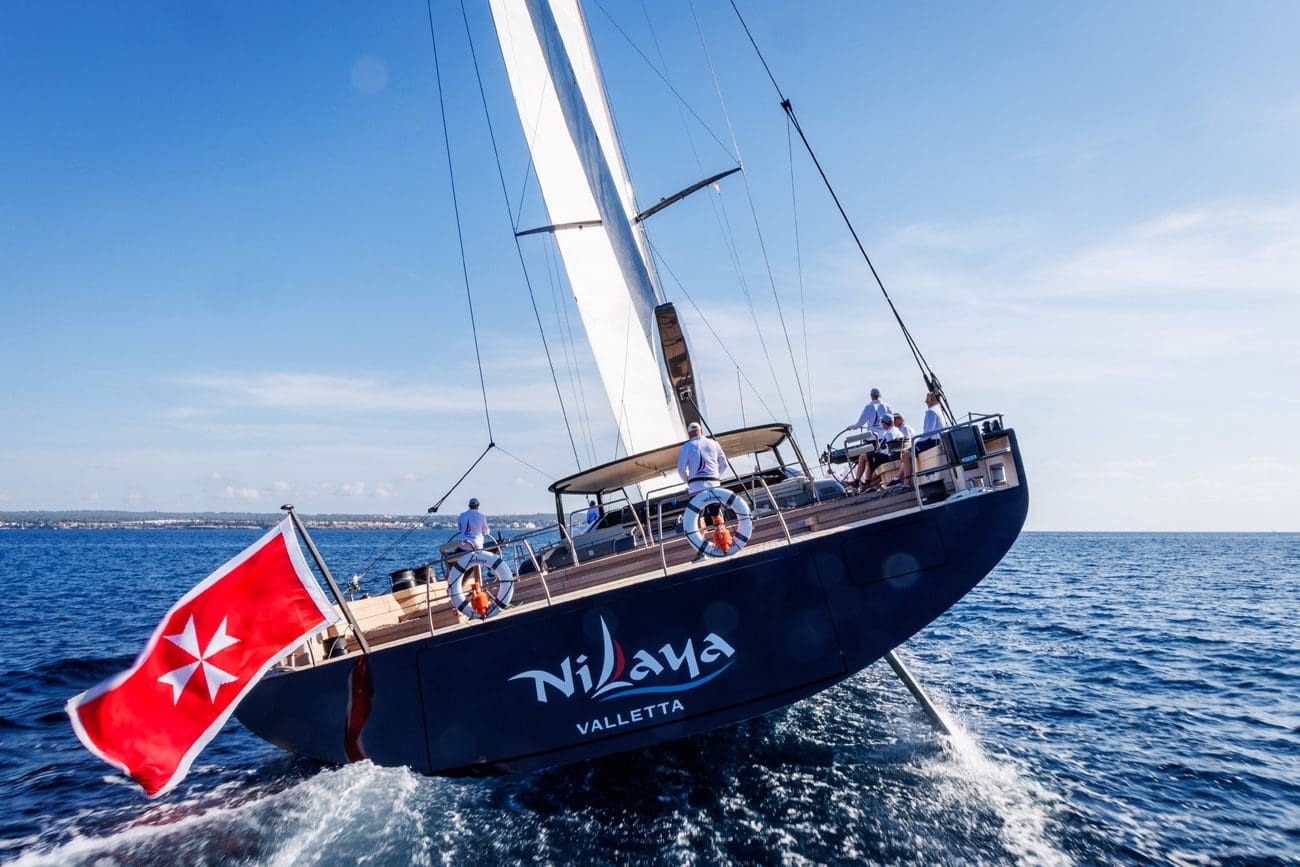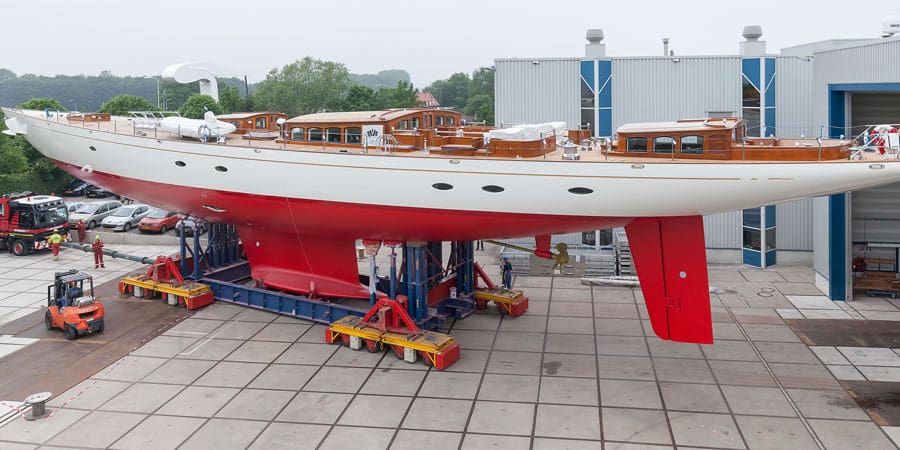The outstanding performance of the 47m Nauta Design and Reichel/Pugh design, skillfully crafted by Royal Huisman, was evident during sea trials in May. Since then, the owner has taken possession of the yacht and begun relishing its remarkable combination of interior comfort and sailing prowess.
Nilaya embarked on a journey to Antigua in late November, completing a ten-day Atlantic crossing that perfectly met the owner’s expectations for speed, durability, reliability, and tranquility. The satisfaction of both the professional race team leader, Bouwe Bekking, and the full-time skipper, Romke Loopik, added to the overall contentment.
Distinguished by its sleek, contemporary lines and cleverly concealed deckhouse, Nilaya captivates the hearts of genuine yachting enthusiasts. Meticulously proportioned, with a modern plumb bow and a straight sheer gracefully tapering to a spacious, open transom, the yacht is instantly recognizable. Enhanced by an exquisite custom carbon sloop rig, Nilaya boasts a Panamax air draft, offering the potential to unfurl an extraordinary spread of sail. Effortlessly reaching speeds of 17 knots on a broad reach with just 18 knots of wind, she embodies a harmonious blend of style and performance.
“Nilaya’s racy, low profile, straight bow and wide aft sections echo the look of her owner’s previous yacht while communicating even greater speed and performance,” says Mario Pedol, co-founder of Nauta Design. “She will be the world’s lightest aluminium sailing superyacht by length, rewriting the story ofhigh-performance superyachts.”
The genesis of this remarkable sailing vessel traces back to the owner’s previous 34m yacht, also named Nilaya – a term signifying ‘blissful home’ in Sanskrit. When the decision was made to upgrade to a larger yacht, the owner was resolute about preserving the deckhouse aesthetics and adventurous spirit. To achieve this vision, he enlisted the same key collaborators for the new project: Nauta Design for the overall concept, exterior, and interior design, Reichel-Pugh for naval architecture, and MCM’s Nigel Ingram as the owner’s representative. The owner challenged them with a demanding task: enhance on-board comfort for a better quality of life with reduced noise levels, all while maintaining speed.
Reichel/Pugh Yacht Design spearheaded a Computational Fluid Dynamics (CFD) study, collaborating with America’s Cup CFD specialists Caponnetto Hueber and Giorgio Provinciali for Velocity Prediction Program (VPP) performance analysis. This exhaustive hull design study aimed to improve sea-keeping and motion, both under power and sail, across various speeds, heel angles, and wave conditions, while also enhancing real and ORCsy rated performance. Twelve models were tested before settling on the final hull shape. VPP results indicated that, in 10 knots of breeze, Nilaya would achieve nearly 13 knots sailing upwind with mainsail and jib, and nearly 18 knots while reaching at a 90° wind angle in a 15-knot breeze.
Although lightweight carbon-fiber construction was initially considered, the design team ultimately favored aluminum due to its compelling advantages. The 47m size of the boat pushed the upper limits of practical molding for carbon-fiber, while aluminum offered unparalleled robustness and quietness—qualities highly valued for a bluewater voyager.
“I started thinking that an aluminium hull weighs 60-70% more than a carbon boat, but the weight of the hull and deck is only about 15% of the total weight of a sailing yacht,” says Mario Pedol. “Our early intuition was that an aluminium construction sailing yacht could be much lighter than the existing aluminium fleet. Royal Huisman supported this vision with enthusiasm and accepted the challenging target of building a light displacement yacht.”
This insightful approach found a powerful ally in Royal Huisman, a global leader in the construction of lightweight aluminum sailing yachts. Leveraging their position, the Dutch shipyard applied the innovative Featherlight methodology, inspired by spacecraft technology. Collaborating with Nauta and Reichel-Pugh, they successfully implemented measures that led to significant weight reductions. Techniques such as adjusting the thickness of Alustar plates, optimizing frame spacing, incorporating lightweight foam-cored paneling, and employing advanced carbon fiber composites for the deckhouse and guest cockpit all contributed to lowering Nilaya’s overall displacement.
The Featherlight™ methodology employed by Royal Huisman utilized Finite Element Analysis (FEA), a design approach rooted in spacecraft technology. FEA modeling involves intricate mathematical geometric computations that predict how a component or an entire product will respond under stress, including various load forces.
“The final outcome represents a new concept in aluminium construction,” explains Pedol. “Nilaya has a displacement which is 15% more than an equivalent full-carbon boat. That’s a lot less than any other comparable aluminium yacht on the water.”
Nauta has drawn on all its long experience to make Nilaya’s exterior profile as beautiful as it is pragmatic. The coachroof blends gracefully with the sheerline, while the wide stern flies above the water, showing off the hull’s double chines. Much thought went into optimising proportions to favour a coaming to protect the guest cockpit and a bulwark to protect the aft cockpit, manoeuvring area, and side passageways. “A wooden plinth between sections in composite and the teak deck makes them visually lighter, and also conceals the string lights that illuminate the deck at night,” says Massimo Gino , co founder of Nauta. “Teak inserts on the bulwarks, coamings and coachroof further enrich the deck.”
Abundant exterior social spaces grace this yacht, meticulously designed with an observant attention to detail. Consider the main guest cockpit nestled under the shelter of the carbon hardtop, where sun loungers aft seamlessly transform into adjustable chaise longues, perfectly aligning with the yacht’s heel. The space also boasts a generous full-sized dining table accommodating up to 14 guests, complemented by two additional low coffee tables, all thoughtfully shielded.
Shift your focus to the foredeck, where a recessed area accommodates the tender. When the tender is either launched or under tow, this space transforms into a cozy forward cockpit adorned with a table and fitted cushions. At the opposite end of the yacht, the expansive 10m-wide transom features a beach club equipped with sun loungers and sofas. A hydraulically operated hinged section of the aft deck unfolds to reveal a staircase leading down to the beach club. This section can be raised to access the crew tender housed in its aft garage.
Nauta’s vision reached into the aesthetics and functionality of the sailing hardware as well – nothing was ‘off the shelf’. “Our customisation of deck hardware included the styling of the 21m Rondal boom, the through-deck fittings for jib sheets, the bollards and other elements,” says Gino. “Removable gate-shaped grabrails were fitted on deck sections from the transom to the guest cockpit for the safety of crew and guests: when the gates are fitted, there are never more than two steps without a grabrail – a useful feature aboard a large yacht where walking distances, when heeled, are a consideration.”
The interior stands as a source of immense pride, delivering the desired exceptional lifestyle for the owner and an optimally efficient service workflow for the crew. The owner’s decorator, May Vervoordt, curated the materials used in the interior styling.
The focal point of the interior is the splendid raised-deckhouse saloon, adorned with a contemporary mix of contrasting woods, light upholstery, and touches of muted blue and terracotta for sofas and cushions. The spacious dining area to port and comfortable lounging space to starboard offer guests panoramic 360-degree views, with a generous skylight connecting them to the wind and sails above. A designated work area in one corner, along with concealed amenities such as a wine cooler, coffee machine, fridge, and ice machine, provide functionality that seamlessly disappears when not in use, including a concealed pantry.
Descending forward and to starboard, the owner’s private domain unfolds. Beginning with a more secluded lounge or TV room, followed by a dressing room, and culminating in the owner’s cabin spanning the entire width of the boat forward. The expansive cabin accommodates a king-sized double bed, an L-shaped sofa, an office area, and a separate bathroom. Addressing the design challenge posed by the cabin’s location beneath the tender bay, Gino notes, “The ceiling balances the tender bay’s central dip with two higher domes at the side passages, giving an excellent sense of the impressive width of the cabin.”
Further forward is a VIP cabin accessible via stairs on the port side of the keel trunk. Two additional guest cabins, each with a Pullman berth, are accessed via an aft stairway and can be configured as twins or doubles through clever sliding joinery. The aft guest lobby incorporates vertical wine coolers and a guest day head.
Occupying the boat’s aft section, the crew area features a dedicated companionway to the aft deck. This space is dominated by a galley to starboard and a mess to port, both generously illuminated by large hull windows promoting natural light and crew well-being. The central corridor leading aft houses dedicated desks for the navigator and engineer, with four ensuite crew cabins, each furnished with bunks.
Nilaya is just starting out in her long career as bluewater cruiser, but it is already clear that she is an exceptional yacht. Her owner pushed for the highest quality throughout the build and he is there in every facet of her design, from that curved Rondal spreaders to the detailing of the interior. Her world-girdling programme is still under wraps, but hopes are high for an appearance at the St Barths Bucket in March 2024.
Nilaya Specs
Yacht name: Nilaya
Length overall: 47m / 154ft
Length waterline: 45m / 147ft
Beam: 10m / 33ft
Draft: 4.5 – 6.9m / 15 – 23ft
Accommodation: 8 – 10 owners / guests + 8 crew
General concept, ext. & interior design: Nauta Design
Naval architecture: Reichel / Pugh
Owners’ newbuild representative: Nigel Ingram, MCM Newport
Owners’ pro race team: Bouwe Bekking
Builder: Royal Huisman
Construction: Aluminum + carbon composite


















